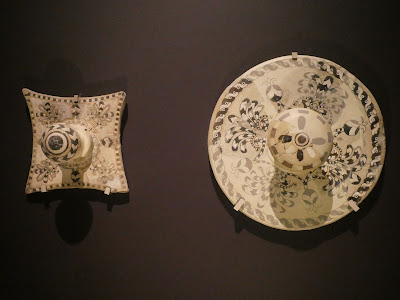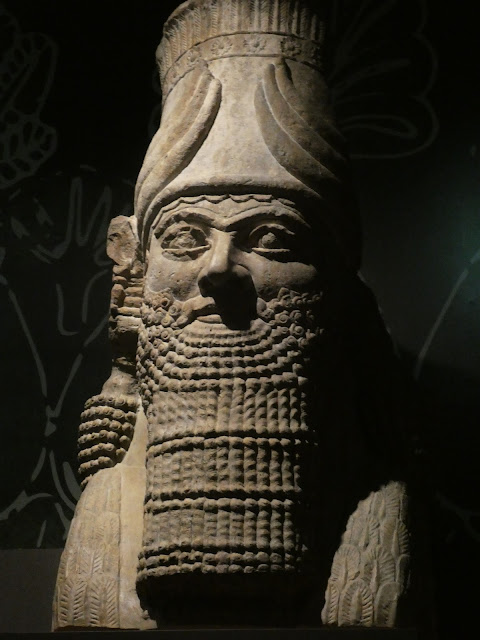An early morning start (relatively) on a fine Saturday so I headed off to this exhibition at the British Museum as it only had a few weeks left.
Now you can split BM exhibitions into two. There are ones that feature stuff from normally one other major collection or are put together for an international tour. Either way they are unfamiliar works. The other type is like this one, largely harvested from the BM's own collection but presented in a different way, augmented with a few extra pieces from around the world. Nothing wrong with this, but you would feel a little put out at paying nearly £20 to see what one could see for free, or is not deemed interesting enough to be put on display in the first place. As a member I feel this less keenly.
The problem with putting on an exhibition about an Assyrian king over 2500 years ago is the rather limited type of the artefacts available. What is most likely to survive is stonework, and so it is here. The Assyrians were not as accomplished sculptors as say the Greeks (although to be fair this exhibition predates classical Greek civilisation by more than a century, so in fact this is rather more impressive than contemporary Greek sculpture would be. So the heart of this exhibition is actually a set of carved friezes in gypsum.
Many of these are very decent from an artistic point of view. The depiction of animals, especially lions, is very skilful. People a little less so. Hadn't really got a grip on how to portray men other than in profile. Some of the attempts at men turning were a little comical.
Much of these carvings were to show the exploits of King Ashurbanipal, not one of the more modest rulers in history. Ok he did conquer all of Mesopotamia, the Levant and even Egypt, so certainly he had a lot to boast about. But the view one gets from this is that the Assyrians were never happier than when decapitating their enemies and making the rivers run red with their blood. One didn't feel they were nice people you would want to get to know. One suspects most early civilisations were frankly far from being civilised. It should make us thankful that we live somewhere in a much nicer age. Although with Isis having so recently occupied the same area, maybe the locals haven't developed much in the last few millennia. Indeed, given that Isis have left only destruction, not art, one might consider that it has gone backwards from a low base.
 |
| Warfare on camel. Having ridden a camel I really wouldn't want to try archery off the back of one. But see how well the camel is depicted? |
 |
| There were some metal artefacts on display, mostly bronzes, but not all Assyrian, but rather Cypriot but said to be of a type used by the Assyrians. |
 |
| Again see how neatly the lion's head is carved? Simple, but very attractive |
 |
| This was a very clever display. This carving is not coloured. The colour is added by projected lighting to show the garden. Ok, they liked their gardens as well their beheadings. |
The exhibition ended with a bit of a film about the preservation of artefacts in Iraq and the destruction of much by Isis. I was chatting about this afterwards in the pub with a young friend of mine who is a classicist and had also seen the exhibition. He considered that there was a hidden subtext here concerning the Elgin Marbles. The subtext being how lucky it is for the world that we had all these treasures preserved here by the British museum compared to what would have happened if the Victorians had left them in situ. Personally I feel that is fair enough. If they had still been in Iraq they would surely now be piles of dust. And the Elgin Marbles would have dissolved in acid rain.









No comments:
Post a Comment